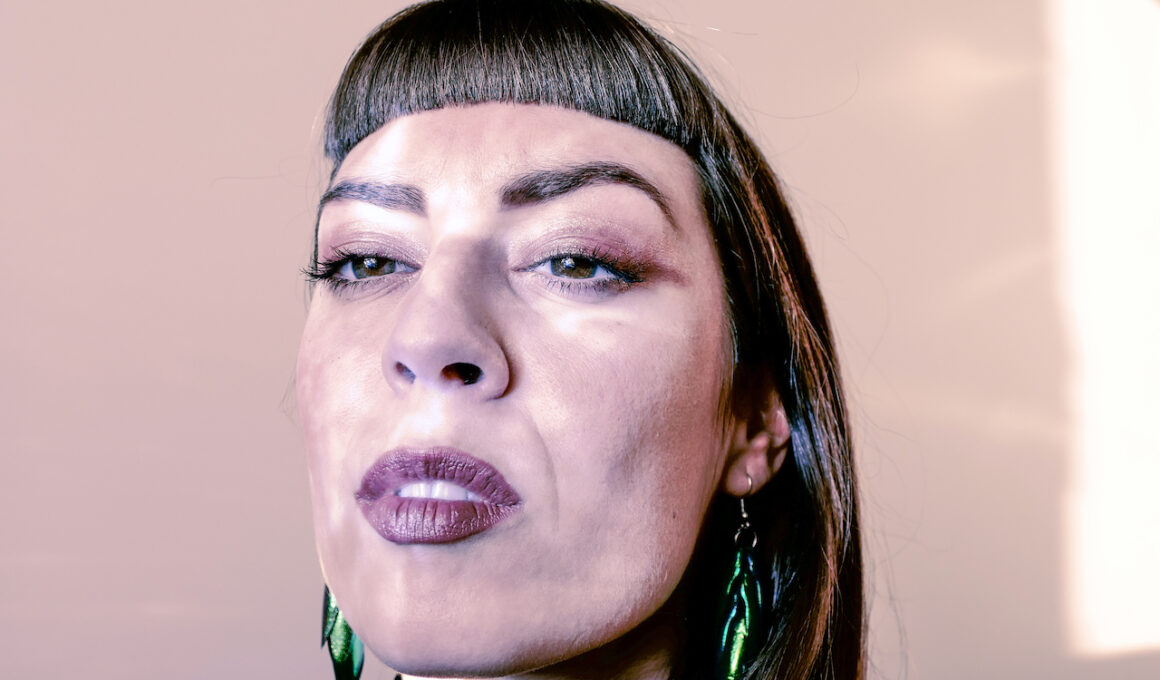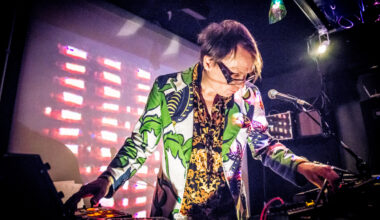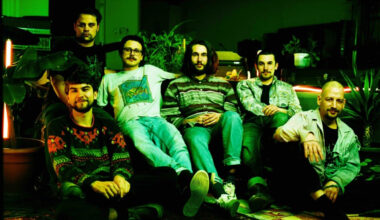Lola de la Mata (b.1991) is a London born French/Spanish conceptual sound artist, composer, curator and musician (violin/voice/electronics) currently based between Liverpool and London.
While her background is in weaving, printmaking and Laban notation, her work sits across performance art, installation and sculptural composition which she develops in collaboration with other musicians, dancers and queer performance artists. As a self taught composer who works outside of traditional western notation, her approach to score making incorporates text, photography and monotypes as graphic scores. Lola’s current research and artistic practice centres around experiences of chronic illness, translation, and personal assistant AI’s use of a ‘neutral’ female voice in corporate products.
FACTS
1. “Fretlessness is a beautiful thing” – Khyam Allami
2. “The secrets are in everybody, including in me, until they are sounded. And when
they are sounded, the secrets are out” – Pauline Oliveros
3. “I’m not convinced I have a body.
Non-conforming bodies, disabled, racialized, women’s bodies – they do not exist. We have no legal existence.” – Paul B Preciado
QUESTIONS
1. What is the biggest inspiration for your music?
A failing fatigued body holding a person hostage and releasing them, sometimes, with the brakes on.
2. How and when did you get into making music?
While doing a weaving and surface design degree in Birmingham,UK, I befriended composers who were taking part in a new music theatre module run by Michael Wolters, which I was invited to join as it wasn’t oversubscribed. The experimentation and play that took place in the sessions was too much for me at the time – I awkwardly clung to corners and shyly allowed others to draw me into their ideas. The following year I dove into learning about Rudolf Laban’s ‘Labanotation’, a method of scoring movement, effort and space for dancers, and developed to end my degree, an installation of 8 tri-faceted columns which spun. Each ‘column’ had 1 mirrored side and two printed with textile designs drawn from Labanotation, which acted as graphic movement scores. I invited dancer Rosie Terry Toogood to improvise her movement from the scores and asked composer Luke Deane to make sonic translations of the patterns. That would probably be the very start! Although it took a few more years where I chased after Labanotation, developed a small movement practice alongside working as a curator PA, and in Curzon Cinemas, before picked up a violin and joining improv sessions at IKLECTIK in London.
3. What are 5 of your favourite albums of all time?
Oof well – this is shockingly difficult. I don’t hold an archive of my top albums that I know of…or even engage with music in the album format, only maybe as a teenager when I listened to NIN, Slipknot, Portishead, Tool… One way to answer would be with the record that felt the most like my interior sound world before I had started to compose: Holly Herndon – Movement. Eliane Radigue – Islas Resonates would be played at Curzon by a friend who clearly formed my ear with her subtle approach to electronics. The technology and collaborative effort behind Bjork – Biophilia with its powerful haunting cries speaks to my soul. I am currently obsessed with
Lafawndah – the fifth season. And an album I keep coming back to Księżyc – Rabbit Eclipse.
4. What do you associate with Berlin?
Sweaty queer bodies + free jazz gig spaces filled with cigarette smoke.
I haven’t been in some years sadly. My first introduction to Berlin was 11 years ago while working at re:surgo (then known as Bongout) in Mitte for a summer, and attending the Berlinale a few years in a row. I remember going to a wild experimental music festival at Radialsystem with Keith Haino + performances of John Cage’s ‘Water walk’ which blew my mind and possibly awakened a desire for more sound in my life! So perhaps it will have to be Radialsystem as the festival in 2012 predates my involvement with music which began quite late in 2015.
5. What’s your favourite place in your town?
FACT Liverpool -art, new media, tech and cinema. I am not usually too taken by video work but FACT Liverpool curates gorgeous, unusual works and place queer practices on centre stage.
6. If there was no music in the world, what would you do instead?
It could only be dance. The fluidity of movement and exchange of rhythm, sculpting with he body, diving into internal worlds…it’s only a small step from sculpting with sound, forming invisible landscapes that appear and recede, that cannot be captured or summed.
7. What was the last record/music you bought?
Jocy de Oliveira - Estórias Para Voz, Instrumentos Acústicos e Eletrônicos (1981)
8. Who would you most like to collaborate with?
Sharon Eyal
Eliane Radigue
Sofia Jernberg
Margerite Humeau
Conrad Shawcross
9. What was your best gig (as performer or spectator)?
Not so much a gig but an installation. At the time I experienced Momentum in 2014 – the swinging light pendulums at curve’s Barbican, I only took in the work was by United Visual Artists, and that I wished to eventually make work like this (I am not there yet). I must have visited the space maybe 10 times…it wasn’t until I came across a new iteration of the work at 180 studios in 2019 I realised it was also Mira Calix’s work. Little did I know I would be handpicked by her for a project with Riot Ensemble and PRS March 2020 and that she would become my mentor and friend, speaking with me almost every day throughout the pandemic, supporting me through health challenges and a community sound art project. It is unthinkable that a force so inspired and always exploring genre-blurring endeavours could be halted. She was and will remain my art guardian angel.
10. How important is technology to your creative process?
Technology for my practice is probably language. I collaborate with individuals who sit across many art forms and outside them. Learning to communicate across these boundaries, because there are definitive manufactured boundaries, is perhaps the most significant technology I engage with. Alongside this, the biggest technological challenge I would say is the brain, how it has to be malleable, and always open.
11. Do you have siblings and how do they feel about your career/art?
I don’t have siblings but I am incredibly lucky to have parents who share the same interests, who attend more art events, music, film and dance performances than anyone I know! They might not necessarily understand my personal references or the cultures I am part of, but will listen to my ramblings even when it makes sense only to me and offer their support.


